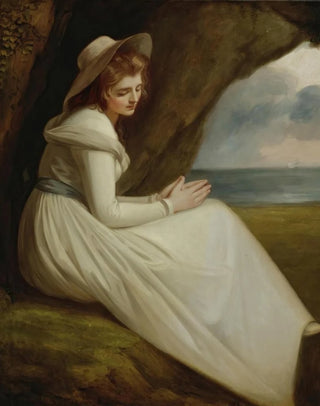Art print | Emma Hart Plus tard Lady Hamilton En tant qu'absence - George Romney


View from behind

Frame (optional)
The artwork "Emma Hart Later Lady Hamilton as Absence" by George Romney is an iconic piece from the 18th century, evoking both the beauty and complexity of the female condition during that era. This depiction of Emma Hart, a muse and a fascinating figure of English society, transcends a simple portrait to become an exploration of themes of identity and absence. Through this painting, Romney does not merely capture the features of his model but manages to infuse emotional depth that invites viewers to reflect on the ephemeral nature of beauty and social status. This masterpiece, a true reflection of a time when art and social life intertwined, transports us into a universe where every detail matters and every gaze seems charged with meaning.
Style and uniqueness of the work
Romney's style is distinguished by its delicate and realistic approach, characterized by subtle brushstrokes and skillful use of light. In "Emma Hart Later Lady Hamilton as Absence," he succeeds in creating an atmosphere that is both intimate and contemplative. The artist plays with shadows and highlights to accentuate Emma's facial features, while giving her an aura of mystery. The composition of the painting, with its blurred background and soft colors, highlights the central figure, which seems to almost float in a timeless space. This work stands out for its ability to capture not only the physical appearance of its model but also the very essence of her being, a quality that makes this portrait a true masterpiece of British art.
The artist and his influence
George Romney, born in 1734, is one of the most sought-after portraitists of his time. His career, marked by travels to Italy and a deep admiration for the old masters, allowed him to develop a unique style that combines classicism and modern sensitivity. Influenced by artists such as Rubens and Van Dyck, he mastered reinterpreting portrait conventions to bring his subjects to life. The relationship he maintained with Emma Hart, who would later become Lady Hamilton, was instrumental in his career.

Matte finish

View from behind

Frame (optional)
The artwork "Emma Hart Later Lady Hamilton as Absence" by George Romney is an iconic piece from the 18th century, evoking both the beauty and complexity of the female condition during that era. This depiction of Emma Hart, a muse and a fascinating figure of English society, transcends a simple portrait to become an exploration of themes of identity and absence. Through this painting, Romney does not merely capture the features of his model but manages to infuse emotional depth that invites viewers to reflect on the ephemeral nature of beauty and social status. This masterpiece, a true reflection of a time when art and social life intertwined, transports us into a universe where every detail matters and every gaze seems charged with meaning.
Style and uniqueness of the work
Romney's style is distinguished by its delicate and realistic approach, characterized by subtle brushstrokes and skillful use of light. In "Emma Hart Later Lady Hamilton as Absence," he succeeds in creating an atmosphere that is both intimate and contemplative. The artist plays with shadows and highlights to accentuate Emma's facial features, while giving her an aura of mystery. The composition of the painting, with its blurred background and soft colors, highlights the central figure, which seems to almost float in a timeless space. This work stands out for its ability to capture not only the physical appearance of its model but also the very essence of her being, a quality that makes this portrait a true masterpiece of British art.
The artist and his influence
George Romney, born in 1734, is one of the most sought-after portraitists of his time. His career, marked by travels to Italy and a deep admiration for the old masters, allowed him to develop a unique style that combines classicism and modern sensitivity. Influenced by artists such as Rubens and Van Dyck, he mastered reinterpreting portrait conventions to bring his subjects to life. The relationship he maintained with Emma Hart, who would later become Lady Hamilton, was instrumental in his career.






